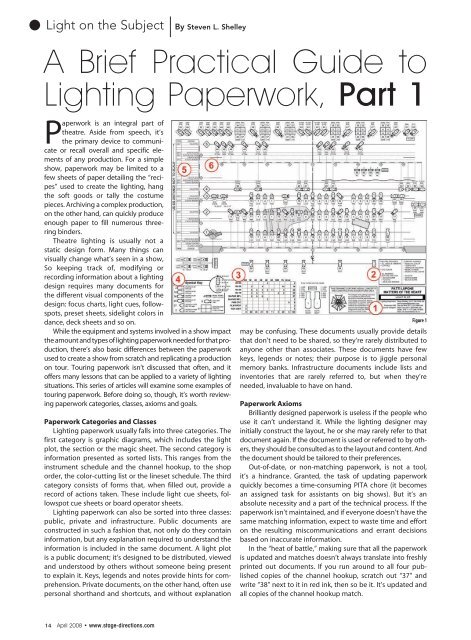Download a PDF - Stage Directions Magazine
Download a PDF - Stage Directions Magazine
Download a PDF - Stage Directions Magazine
You also want an ePaper? Increase the reach of your titles
YUMPU automatically turns print PDFs into web optimized ePapers that Google loves.
Light on the Subject<br />
By Steven L. Shelley<br />
A Brief Practical Guide to<br />
Lighting Paperwork, Part 1<br />
Paperwork is an integral part of<br />
theatre. Aside from speech, it’s<br />
the primary device to communicate<br />
or recall overall and specific elements<br />
of any production. For a simple<br />
show, paperwork may be limited to a<br />
few sheets of paper detailing the “recipes”<br />
used to create the lighting, hang<br />
the soft goods or tally the costume<br />
pieces. Archiving a complex production,<br />
on the other hand, can quickly produce<br />
enough paper to fill numerous threering<br />
binders.<br />
Theatre lighting is usually not a<br />
static design form. Many things can<br />
visually change what’s seen in a show,<br />
So keeping track of, modifying or<br />
recording information about a lighting<br />
design requires many documents for<br />
the different visual components of the<br />
design: focus charts, light cues, followspots,<br />
preset sheets, sidelight colors in<br />
dance, deck sheets and so on.<br />
While the equipment and systems involved in a show impact<br />
the amount and types of lighting paperwork needed for that production,<br />
there’s also basic differences between the paperwork<br />
used to create a show from scratch and replicating a production<br />
on tour. Touring paperwork isn’t discussed that often, and it<br />
offers many lessons that can be applied to a variety of lighting<br />
situations. This series of articles will examine some examples of<br />
touring paperwork. Before doing so, though, it’s worth reviewing<br />
paperwork categories, classes, axioms and goals.<br />
Paperwork Categories and Classes<br />
Lighting paperwork usually falls into three categories. The<br />
first category is graphic diagrams, which includes the light<br />
plot, the section or the magic sheet. The second category is<br />
information presented as sorted lists. This ranges from the<br />
instrument schedule and the channel hookup, to the shop<br />
order, the color-cutting list or the lineset schedule. The third<br />
category consists of forms that, when filled out, provide a<br />
record of actions taken. These include light cue sheets, followspot<br />
cue sheets or board operator sheets.<br />
Lighting paperwork can also be sorted into three classes:<br />
public, private and infrastructure. Public documents are<br />
constructed in such a fashion that, not only do they contain<br />
information, but any explanation required to understand the<br />
information is included in the same document. A light plot<br />
is a public document; it’s designed to be distributed, viewed<br />
and understood by others without someone being present<br />
to explain it. Keys, legends and notes provide hints for comprehension.<br />
Private documents, on the other hand, often use<br />
personal shorthand and shortcuts, and without explanation<br />
Figure 1<br />
may be confusing. These documents usually provide details<br />
that don’t need to be shared, so they’re rarely distributed to<br />
anyone other than associates. These documents have few<br />
keys, legends or notes; their purpose is to jiggle personal<br />
memory banks. Infrastructure documents include lists and<br />
inventories that are rarely referred to, but when they’re<br />
needed, invaluable to have on hand.<br />
Paperwork Axioms<br />
Brilliantly designed paperwork is useless if the people who<br />
use it can’t understand it. While the lighting designer may<br />
initially construct the layout, he or she may rarely refer to that<br />
document again. If the document is used or referred to by others,<br />
they should be consulted as to the layout and content. And<br />
the document should be tailored to their preferences.<br />
Out-of-date, or non-matching paperwork, is not a tool,<br />
it’s a hindrance. Granted, the task of updating paperwork<br />
quickly becomes a time-consuming PITA chore (it becomes<br />
an assigned task for assistants on big shows). But it’s an<br />
absolute necessity and a part of the technical process. If the<br />
paperwork isn’t maintained, and if everyone doesn’t have the<br />
same matching information, expect to waste time and effort<br />
on the resulting miscommunications and errant decisions<br />
based on inaccurate information.<br />
In the “heat of battle,” making sure that all the paperwork<br />
is updated and matches doesn’t always translate into freshly<br />
printed out documents. If you run around to all four published<br />
copies of the channel hookup, scratch out “37” and<br />
write “38” next to it in red ink, then so be it. It’s updated and<br />
all copies of the channel hookup match.<br />
14 April 2008 • www.stage-directions.com

















